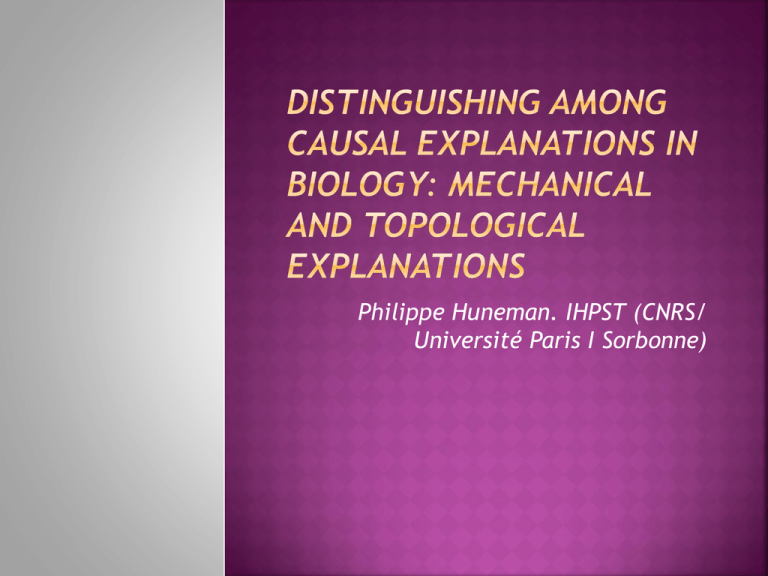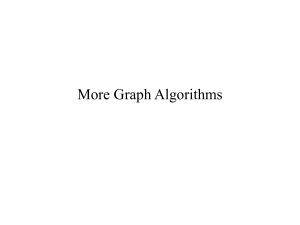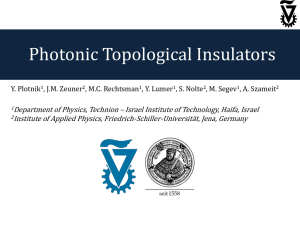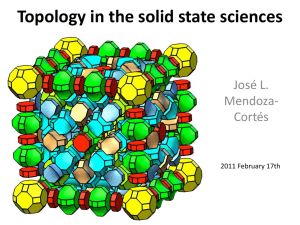
Philippe Huneman. IHPST (CNRS/
Université Paris I Sorbonne)
Models
-
-
of explanation in philosophy of
science
Causal explanations (Salmon, 1984)
Unifying explanations (Friedman 1963,
Kitcher 1969)
-
The two models are rather two poles
(combinations are possible (eg Strevens 2004))
Often
causal explanations mean : identify
processes or mechanisms) displaying the
phenomena.
(Salmon 1984; Wimsatt 1982; Craver Machamer
Darden 2000, Craver 2007
In
this view the role of counterfactuals is
downplayed
Very
accurate concerning many aspects of
neurosciences (Craver 2007), molecular
biology (Darden 2003)
Here
: in addition, define and consider
« topological explanations »
-
-
Present in ecology, evolutionary biology, social
sciences, etc.
Do not pinpoint mechanisms
Influential with the rise of network science, and
the inflation of « neutral systems » (Hubbell,
UNTB/ Stadler and Schuster, etc.)
Are a kind of causal explanations in a
counterfactual sense
Topological explanations: nature and role
I.
I.
II.
III.
The nature of topological explanations
The pervasiveness of topological explanations in
community ecology
Topological vs mechanistic explanations
Mechanical and topological explanations
reconsidered.- disjunct, combined
II.
I.
II.
III.
III.
Disjunct explanations : the case of robustness in
living systems
Neutral spaces, neutral networks
Combining mechanism and topological explanations
A general view of causal explanations in
biology
Part I.
I.A.
Two
strains of
bacteria with
distinct distributions
of mutations in
competition,
varying the
mutation rates m
two types of
topological
structure of
populations in
fitness space –
sharpness, flatness
The probability that a mutation displays a
large drop in fitness as compared to the
current alleles is clearly a consequence of
the shape of the curve, because it only
depends on the fitness distribution of
possible mutations. And this probability is
what determines the evolutionary fate of
each strain
1.
Topological properties:
System S, properties Ti, related to some space:
how parts of the system are located
regarding one another, etc. The “parts” can
be parts of a more abstract space:
Phase space
Community ecology : parts are species/ cluster of
species in a (foodweb) graph
S has elements, parts, features or capacities,
moments of its regular behavior, or of the set of
its possible behaviors, which are likely to be
represented in a graph, a network or a variety S’
in a space E.
S’ will have topological properties Ti, namely,
properties which specify its invariance under
some continuous transformations, and which will
determine equivalence classes between all
structures S* homotopic to S’. Or, if S is a graph,
you can specify some properties of S’ (e.g.
connexity; cyclicity, etc.) which will define an
equivalence class, and distinguish S’ from other
graphs S* not having those properties.
S
has topological properties in virtue of its
relation to S’ and its elements and relations
Eg. Lenski’s bacteria strains have the properties of
“flatness” and “sharpness” in virtue of their
essential relations to their mutations distribution.
Two consequences
S realizes the topological properties Ti, and
many Sj can be said to be equivalent because
they realize the same Ti (for example, belonging
to the same equivalence class defined by
homotopic paths in some space)
Ti have many consequences, especially, they
may constrain the possible transformations of S’,
for example because all continuous
transformations should lead to some homotopic
structure S’’.
2. Topological explanation
an explanation in which a feature, a trait, a
property or an outcome X of a system S is
explained by the fact that it possesses
specific topological properties Ti.
The topological explanatory relation implies that
whatever possible process Bj occurs to S that involves
some or all elements or parts of S, no Bj is sufficient
to account for X, but the simple fact that S realizes
Ti entails as a consequence the fact that S has X.
It may be that a given X causally results from some
Bj, but that what explains X is not the Bj itself;
eg. causal process Bk also produces X, but that the
topological properties Ti which constrain in the same
way all processes Bi, entail that whatever the process
Bj, the outcome will be of type X -> the causal
process Bj itself does not make any difference
(conditionally on the fact of Ti) to the outcome and is
therefore not explanatory.
--> Explanation of X goes like a relation of
entailment between topological properties Ti
and X or features of X, and not like the
display of a mechanism from which X would
be a temporal outcome.
Phrase
« Topological explanations »: frequent
in maths; in quantum physics (Arcos &
Pereira 2007) – but about already
mathematical entities (spin etc.)
Yet in biology, ecology etc. those are
pervasive,
I.B.
« The more diverse a community is, the more
stable it is in its composition »
Classical until the 70s
May 1974: mathematically it’s not the case
Thus: Need to define diversity (functional ?
Number of species ? ) and stability (of
composition ? Constancy of a biological
property (eg biomass); persistence (no
species get extinct); resilience
-> Various modes of the hypothesis:
Tilman 1996 (constancy of biomass); etc.
Basically, May’s model assumed random
connections between species; but this is not
realistic.
Hence: exploring various consequences of
specific connectivity schemes upon kinds of
stability
Variables:
the number of species and
their average number of
links,
the number of connections
realized between species
as compared to the
number of possible
connections
(connectance),
the distribution of the
connections between
species.
Solé and Montoya 2001; Dunne et
al. 2002; Mc Cann et al. 1998;
Montoya and Solé 2006
Many ecological interactions
(competition, predation,
mutualism); some graphs
are drawn without
considering even the
nature of the causal
relation (Montoya and Solé
2006)
Network with 2 hubs and lots of
poorly connected species
(464).
Deleting one species: chances
to delete only an isolated
node (hence not changing the
pattern) are 232 times higher
than chances to alter the
pattern
S : the community
S’: the network of interactions
T: property of having two hubs.
T entails that the probability of
altering the pattern with one
species extinction is very
low-> stability
Scale-free networks : distribution of
connections varies according to a power law
– hence, few big hubs, many slightly
connected nodes
Production rule : preferential atachment (rich get
richer) (P(n) ~ n)
Small worlds (two nodes are always close, high
level of clustering);
Production rule – adding random links
Scale
free networks - deleting randomly a
species has many chances to affect poorly
connected species, hence the stability of the
community through conservation of quite all
the links
Internet has the same property (Solé et al. 2001);
also some financial systems (Levin et al. 2008)
Many ecological networks are often not exactly
random but almost (truncated scale free
networks) – hence the consequence of stability
Small
world networks – disconnect two
species A & B (by deleting an intermediary
one between them ) then there exists a
cluster where A is where there is a species
closely connected to B.
S’ the interaction network
T: « Being a small work »
Entails stability (robustness viz. Species extinction)
These are topological explanations : they deduce
the stability property from the topological
property of the network of connections, without
considering the dynamics, the causal
interactions between species, etc.
In both cases, if S1 has lots of preying species and S2
lots of parasitic species but S’1=S’2, the same
explanation for stability holds.
Stating the formal property – e.g., the relative
number of small and large hubs – immediately
yields the result, no matter what are all the
temporal mechanisms which can happen in the
community.
I.C
A
mechanism is defined by entities and
activities (MDC 2000); here no specific
activities and entities are identified.
For ex. in the « survival of the flattest » what’s
explanatory is the topology of the mutations, not
the mechanisms (the same in both cases)
A ->B->C->D
A ->B- / D
C extinct, B decreases
in frquency, D
increases
Vacant niche appears
Other species C’
replaces C
A->B-> C’ -> D
The food web is a
scale free network
Probability that a
random species
extinction alters the
community structure
is therefore low
Mechanistic explanation
Topological explanation
Mechanisms
It i s in virtue of X’s y-ing,
that Y and Z will for example
be triggered to do J and K,
and then make the system S
likely to be f -ing as a result
of combined J and K.
The explanandum of a
mechanistic explanation is
determined by stating the
“set-up” and “termination”
conditions. The chronology of
sequences through which
entities act is crucial to
explain the production of this
termination condition
Topological explanations
There are no specific activities
listed: no matter what the
species do, whether they
prey or not, whether they y
or they f, and on whom etc.
Stability rather occurs
because of some network
property of S’.
Another difference = the
temporal sequence between
events in topological
explanations is irrelevant,
since switching the order of
events does not affect the
explanandum
Suppose
that two systems S1 and S2 have the
same associated shape S’ in abstract space
but that the relata of links in S1 are J and K,
and in S2 are J2 and K2, with their distinct
associated activities. Yet the topological
properties of S’, realized identically by S1
and S2, will not be affected by this
difference of activities and properties;
therefore the identification of mechanisms in
S1 and S2 is not relevant for explaining their
outcomes
Part II.
2.A.
A capacity to keep some parameters stable in the face of
changing variables.
All modes of stability mentioned above in ecology satisfy
this characterization.
• Increasing researches about robustness in biology (Kitano 2005, de Visser
2002, Wagner Robustness and evolvability in living systems)
Two more specific characterizations:
a. “level” definition, in the sense that change in low level
variables doesn’t involve change in high level variables –
for instance changing the identity of several species does
not affect some general properties like biomass or
abundance pattern.
b. “functional“ definition: robust are the systems able to
maintain (some of) their functions in the face of
perturbations.
Homeostasis
(Cannon – Physiology) is an
important kind of physiological robustness
«
Canalisation » (Waddington) means
robustness of development against genetic
noise
Communities
Homeostasis
Developmental pathways
Metabolic pathways
Gene networks
proteins
Redundancy : many codons yield the same amino
acid
-> often, changing A to C, G to T etc., does not
change the functional product
In general: Redundancy is an explanation of
robustness (and also of evolvability)
Other kinds of robustness do not involve
redundancy but « distributed robustness » (most
of them, Wagner 2005b)
-> an example of distibuted robustness (at the
gene level): gene regulation network of Endo16
(sea urchins)
a.
proximate : how
is it ensured? (->
why does
distributed
robustness
occurs?)?
About a .Many kinds of
explanations; they
can be partitioned
into mechanical vs.
topological
explanations
b. evolutionary –
b1), why has it evolved?
b2) what role may it
play in evolution
About b1. Articulating
genetic and
environmental
robustness.(What has
been selected for ?)
Mechanisms
• Feedback control
(physiological homeostasis;
lactose operon)
• Weak linkage (Gerhardt and
Kirschner 2005)
• DNA repair systems (-> fct
of sex (Michod and
Bernstein 1996))
Topology
• Modularity
• Redundancy
• Neutral spaces (Stadler,
Schuster et al.; Wagner
2005)
• Small world topologies
• « aristocratic networks »
(laszlo barabasi)
The
fact of diploidy and the mechanisms of
recombination are such that if DNA is
altered, another copy is intact which can be
a template for DNA repair. In this sense
robustness of DNA is produced by this ability
to copy on the basis of a second haplotype as
a template.
(Modularity is a highly clustered network)
It reduces the effect of perturbations because
those won’t break the whole systems, since
they have chances to concentrate upon only
one module, the others being likely to still
function.
An explanation for evolvability (Altenberg and
Wagner 1996)
Many
topological properties : defined by
invariance regarding to deformation
Stability : reaction viz. perturbation; in the
S’ associated to system S , a « perturbation »
is a « deformation »
Therefore, topological equivalence classes
(ie shapes S* which are invariant trough
continuous deformation) determine kinds of
stabilities
Hence topological properties are often
related to robustness properties
2.B
Many
different sequences, due to the laws of
chemistries and the requirements of
minimizing free energy, fold into the same
spatial structure (ie, with the same
molecules at surface sites, hence
functionally behaving similarly).
The
space of structures is such that few
structures are reached by several large sets
of RNA sequences, whereas many structures
are reached only by a few sequences.
Defining
a distance between two sequences
G’G’ as the number of mutations needed to
get from G to G’
Defining the set G1 of sequences such that
f(H) = f (G) and d (G, H) = 1; same operation
with each H in G1 etc.
Gives a neutral network – all Hs in it are
accessible from G by a series of mutations
without changing the phenotype
Stadler and Stadler, 2001; Otalloni and Stadler, 2007; Van Nimwegen, Huynen
and Crutchfield, 1996; Stadler, Fontana and Schuster 2001, Fontana et al., 1992
Wagner 2005
Gavrilets 2004 (neutral tunnels)
Explains mutational robustness: if G is deep in a neutral
network, mutations will not alter the phenotypes
Explains also evolution from low to high fitness with drift
(through a neutral network)
Genetic robustness of some genotypes is the topological
structure of the GP map, and the specific position of the
genotype x in this structure. Once again, no mechanism of
gene-protein interaction has to be hypothesized in order to
understand such robustness.
And those neutral spaces allow biologists to formulate
issues about the evolution of robustness (the more robust
is a system, the larger are the neutral spaces in it) and the
roles of robustness in evolution.
Neutral spaces are also likely to explain :
the robustness of the genetic code (by devising a
space of alternative genetic codes (Wagner,
2005, 198),
as well as the robustness of gene expression
(like in the case of Endo 16).
This latter case is easily described by a space of DNA,
which maps each regulatory DNA regions onto a
specific expression. Some genes like Endo 16 will be
regulated by many alternative regulatory regions, and
one can define the set A of regulatory DNA regions
expressing the same gene. Very likely, A can be
partitioned into several neutral spaces, and a very
robust gene (regarding its expression) like Endo 16,
will have a large neutral regulatory space associated.
2.C.
Not any relation is relevant in topological
explanations (in the graphs)
In ecological explanations here : consider only
ecological interactions (preying, parasiting
etc); not « bigger than », etc.
The topological explanations take a subset of
all relations and consider them as relevant,
abstracting away from their causal nature;
The mechanistic explanation considers the
causal nature of these causal relations (but
sometimes equate them)
1. Why has this ecosystem stability properties ?
Because S’ is a scale free network.
topological explanation
2. « Why is S’ a scale free network ? » Because
preying is built up according to a
preferential attachemnt rule .
mechanistic explanation
3. « Why are many ecosystems having scale
free foodwebs? » -> general properties of
the preying and parasitism relations
causal, possibly mechanistic,
explanation
A
complete explanation (here: of stability of
ecosystems) as a sequential explanation
(involving mechanisms and topologies).
Pure
Topological Explanations (examples
given)
Constraining
Topological explanations –
there are causal mechanisms but the
topological properties are constraining their
action and therefore the explanations
Example:
Evolution-of-cooperation research (Nowak 2005; Pacheco
and Santos 2006)
Mechanism : altruists
tend to interact to
individuals with
(relatively) high
propensity to be
altruists (eg kin
selection, Hamilton’s
rule).
Topology: forms of the
interaction network
(small worlds increase
the chances to meet
individuals alike)
Attractors (periodic) /
strange attractors
(Ruelle & Taken, etc.)
Once
attractors are found in the phase space
Then topological properties of the attractor
may explain some of the trajectories
Suppose a state space of a system with an attractor.
Given only its topological properties one can deduce
many things: the time before getting into chaotic
regime, the chances of ending up in one rather than in
another, the possible bifurcations (Feigenbaum 1978),
etc. So those explanations do not consider the
mechanical processes proper to the system.
-> Is it a pure topological explanation ?
No : such explanation elaborates on mechanical
explanations and causal knowledge used to
construct the phase space and the attractor
In a second step, then, studying the topology of
the attractor may support conclusions about new
properties of the trajectories of the system
So attractor studies define another kind of
explanation, which somehow mixes topological
and mechanical kinds of explanations (it’s a
« secondary topological explanation »?)
Mechanistic explanations:
Intralevel : causal relations
Interlevel : constitutive relations (Craver 2007)
-
“there is a temptation to say that the activation of cyclic
GMP phosphodiesterase, which catalyzes the conversion
of cyclic GMP to 5c/-GMP, causes rod cells to
hyperpolarize, which in turn causes the eye to transduce
light into neural activity. But the activation of cyclic GMP
phosphodiesterase is part of the activity of
depolarization, which is part of the eye’s transduction of
light” (2006, p. 15)
S system; Mi subsystems; Nj, parts of subsystems
Mi, causing Mi’s outcome. But they contribute to
constitute S’s activity.
A possibility : the
subsystems are not
explained mechanistically
, but by topological
explantions.
Topological
ly explained
stability
Example: « pseudoGaia »
hypothesis – Earth is a sort
of organistic whole with
regulative
« physiological »
feedbacks; ecosystems are
part of it. The stability of
some ecosystems is
constitutive of the Earth’s
regulative activity; but it’s
topologically explained.
Feedback
mechanism yielding
resilience
Part III
Displaying Mechanisms : you don’t need to
consider counterfactuals relations (what
would hold if part A is not here etc.)
The display of the mechanism is explanatory.
Topological explanations : you abstract away
from mechanisms.
The causal nature of interaction is irrelevant
(predation and parasitism may fall into the
same equivalence class)
Question : is it still a causal explanation ?
S,
system, S’ associated abstract shape, P
topological properties, X
property/behaviour/outcome to be
explained.
« If S had not P (in virtue of S’) the
outcome/behaviour X of S would not be
what it is »
-> topological explanations involve
counterfactual dependencies (whose relata
partly belong to the abstract space E
associated to S)
In life sciences causal explanations are:
a. Displaying mechanisms
b. Topological explanations – counterfactual
c. Mixed forms of both. (Constrained
topological explanations, sequence of
explanations, attractor explanations, etc.)







